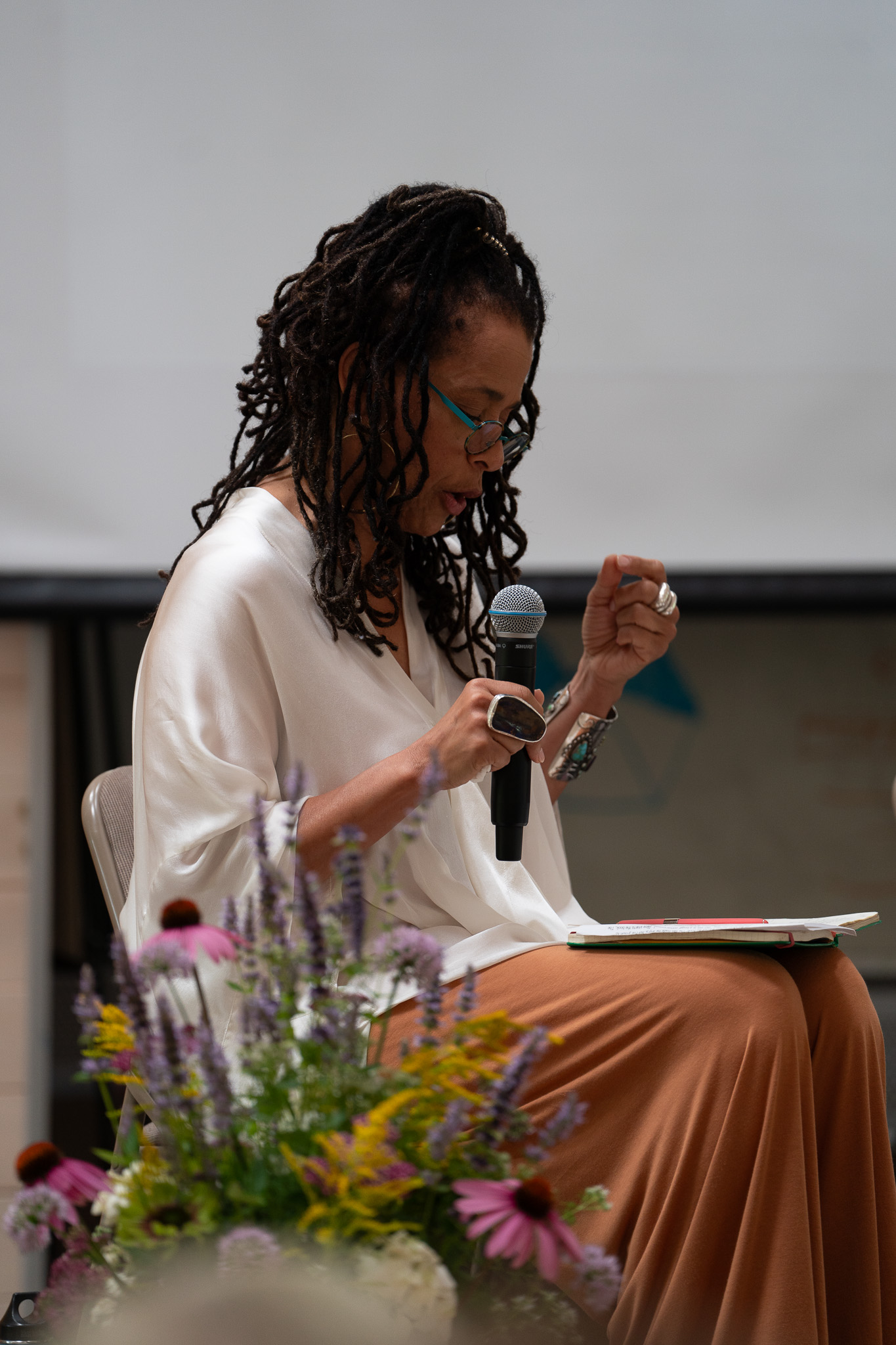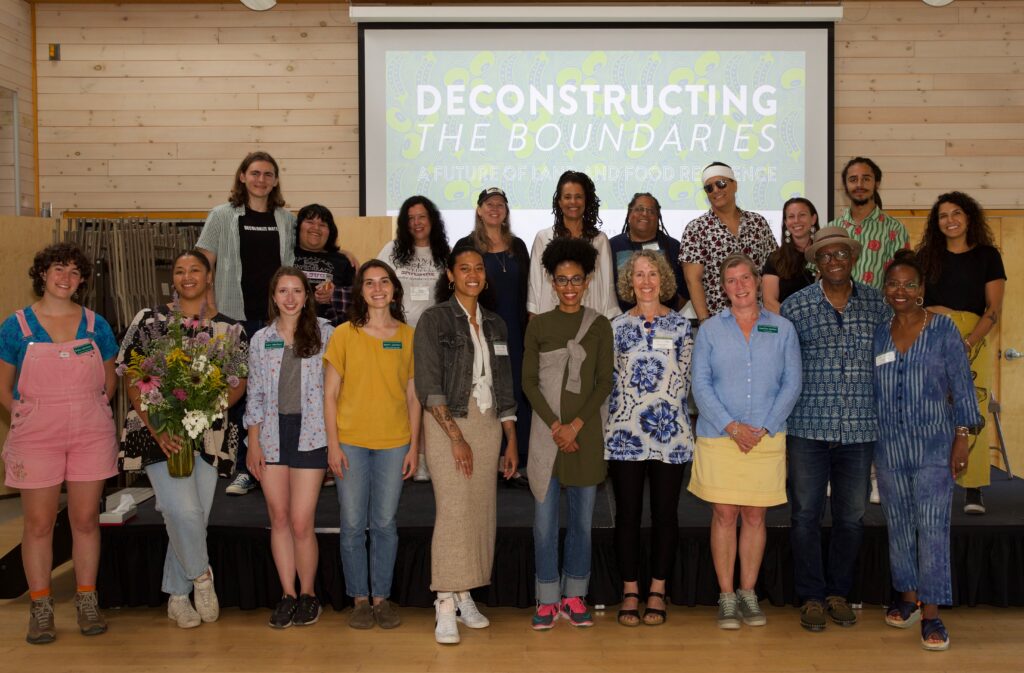As a lead up to this year’s Indigo Arts Alliance and Coastal Maine Botanical Garden’s Deconstructing Boundaries: The Land Fights Back event, we are reminded of our shared responsibility to the land and to each other. Carolyn Finney participated in our 2023 Deconstructing the Boundaries: A Future of Land & Food Resilience. As we enter year two of our partnership with CMBG, her essay, “The Land on Which We Stand,” reflects on her 2023 symposium experience and invites us to confront the complex and painful history that shapes our present and to envision a future grounded in justice, healing, and creativity. Through powerful reflections and a call to action, Finney challenges us to engage in meaningful conversations about land, belonging, and the power of art to transform our world.
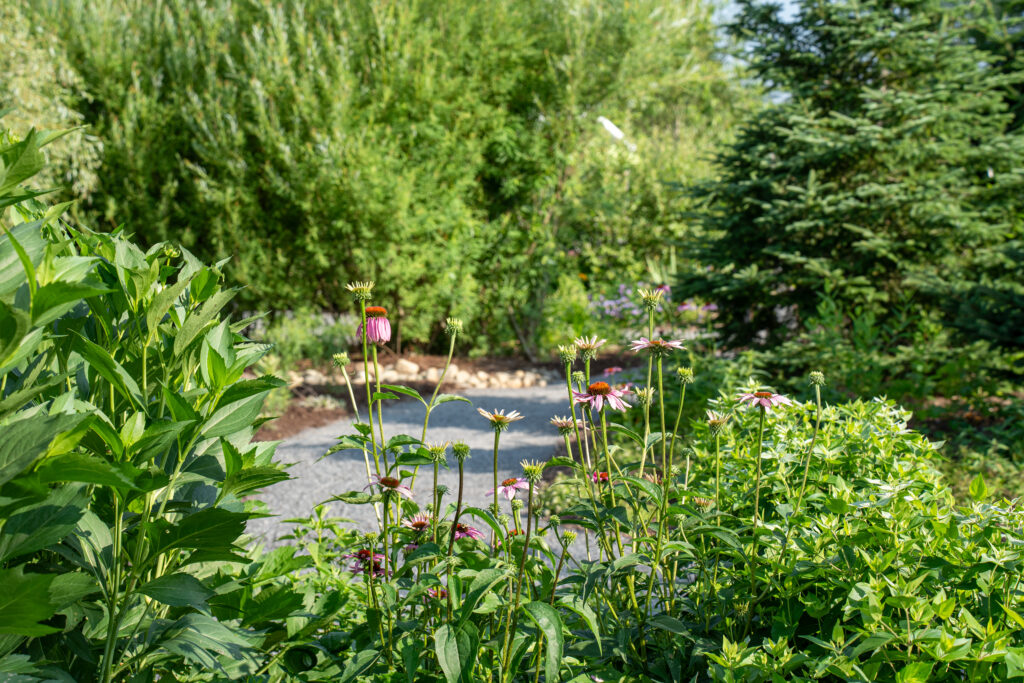
The Land On Which We Stand.
What is our responsibility to the land on which we stand? How are we accountable to a past that continues to define our present and our presence? Can we break the cycle of dis-ease that informs our relationship to the earth and each other?
I don’t know about you, but the world seems to be spinning on its axis and at times, I feel like I am barely holding on. My heart is broken and I find myself drowning in disillusionment, anxiety, fear and sadness. We are at war with everything, it seems – our past, the environment, and with each other. Old systems and ways of doing things are breaking down and many of us are falling into the cracks. Disruption, intentional and otherwise seems par for the course. We can’t see the forest for the trees and soon there may be neither. One could say that we are in a cultural and environmental freefall.
At the center of this geologic shift is the question of who we are as a nation and as a people. Who belongs and who doesn’t? Loss of power, position and place, both literally and figuratively, informs the fear and mistrust we have of each other. Our past continues to haunt us, the legacy of which can be found in our policies, our institutions, and in our belief systems. Whether we define home as our local community or the roof over our heads, we don’t exist in isolation from the larger processes that define this country and our world. And many of us carry that history with us. And the land remembers.
Two facts will always be true: all this land was stolen & we enslaved a group of people to build the backbone of our economy. Manifest Destiny – or more specifically, the expansion of the United States across the North American continent between 1816 and 1860 – became the umbrella under which certain practices and legislation could be justified in relation to the removal of Indigenous people from the land on which they called “mother”, on which they called home. Indian Removal and the acquisition of property by Euro-Americans, was both violent and unapologetic. From the implementation of the Homestead Act, the creation of “reservations” to the Trail of Tears, indigenous people were subject to having their children taken away and placed in boarding schools, watching their numbers shrink in large part because of the diseases that Europeans brought to this continent, and being relegated to land that was both unfamiliar and unrelated to their cultural history and practices. Along with the Chinese, Irish, South Asian, and Mexican immigrants (among others), this land is filled with the blood of our ancestors from all walks of life. But even as I write this, some states are working to strike these conversations from our places of learning, from our libraries and from our common conversation.
David Treuer, an Objibwe writer & scholar, in a piece entitled, “Return the National Parks to the Tribes” (The Atlantic, April 12th, 2021), writes about the bloodshed, “staggering loss”, and humiliations endured by indigenous people. He also reminds us that these same people have been caring for this land for thousands of years. And that their love for the land runs deep.
National Parks are not just repositories of our collective histories, or places for us to recreate, but they are also reminders to many indigenous peoples of what they lost. Of what was stolen. How do we hold those feelings as a nation? At the end of this well-researched, and compelling piece, Treuer states that “The national parks are the closest thing America has to sacred lands, and like the frontier of old, they can help forge our democracy anew. More than just America’s “best idea,” the parks are the best of America, the jewels of its landscape. It’s time they were returned to America’s original peoples.” Are we ready and able to have this conversation? How do we deal with resistance, loss of power, the decentering of a “white” experience and ownership over land, narrative and way of life? How do we deal with a kind of debunking of the American story?
But in reality, these green spaces are reflections of a “capitalist and colonist nature” that has exploited plants, animals and people for the benefit of those privileged enough to determine who thrives and who doesn’t. Who survives and who doesn’t.
And what of reparations? How is the “American story” further complicated by the blood and sweat of thousands of enslaved Africans who were ripped from their homelands, their dreams and their humanity to work this stolen land under the threat of the lash and the rope? While rarely being able to bask in the rewards their labor produced? The Emancipation Proclamation (issued by President Lincoln in 1863) would initially allow approximately forty thousand recently freed men and women to receive four hundred thousand acres of abandoned Confederate land and the Freedman’s Bureau Act was put in place in 1865 to manage this process. But a year later, at the behest of white plantation owners who feared the wealth and power that newly minted black landowners would accumulate, Congress defeated the portion of the Freedman’s Bureau Act that facilitated giving land to freedmen and President Andrew Johnson ordered all land titles rescinded. Over the next forty years, legislation was passed that would limit both accessibility and movement of all non-white people, particularly Black and Indigenous people. This included the California Land Claims Act (1851), the Black Codes (1861-55) and the Dawes Act (1887) (Black Faces, White Spaces).
“This is precisely the time that artists go to work. There is no time for despair, no place for self-pity, no need for silence, no room for fear. We speak, we write, we do language. That is how civilizations heal. I know the world is bruised and bleeding, and though it is important not to ignore its pain, it is also critical to refuse to succumb to its malevolence. Like failure, chaos contains information that can lead to knowledge- even wisdom. Like art.”
-Toni Morrison, Nobel Laureate
Land back. Reparations. Restitution. Rematriation. I feel I need to pause for a moment and be transparent: as an African American writer, scholar and activist, I’ve been pursuing these questions for the past twenty years. This year is the ten-year anniversary of my first book, Black Faces, White Spaces: Reimagining the Relationship of African Americans to the Great Outdoors (UNC Press) where I explored the relationship between national parks, representation, conservation, and narratives around land, belonging, national identity and race. This work – this conversation – has always been personal as I believe it is for many whose ties to land and home have been defined by the contours of a singular history that at best did not always see them and at worst, would ignore, deny, and even erase their/our presence. It is something to be invisible in an origin story where your ancestors played a central role in its creation.
Is there a new story to tell?
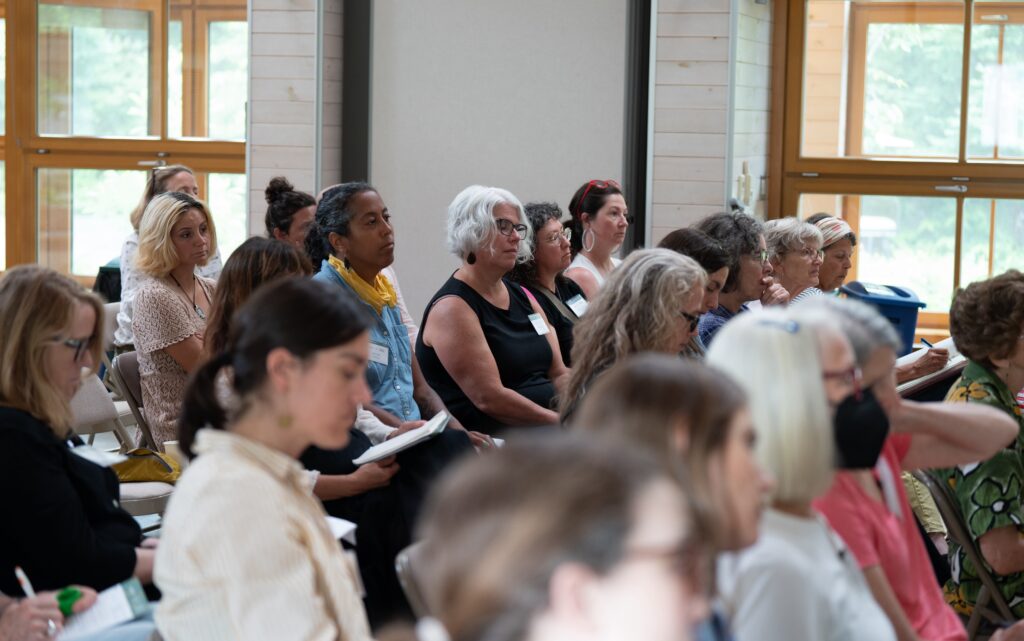
There are organizations and individuals who are stepping up and stepping out in creative and exciting ways to offer us the space and time to lean into these challenging conversations. One such organization is Indigo Arts Alliance in Maine, the only “Black-led, established arts incubator in northern New England” who are determined to work with diverse communities to find a way through. Founded in 2018, this group of committed and thoughtful artists and activists led by Marcia and Daniel Minter are intentional in their effort to support a “multiracial democracy” by “promoting engagement through participatory events that bring artists’ and activists’ work into public conversation on social justice, culture, and community”. Art and activism can be about healing, connection, learning and dreaming into the future in new and audacious ways and Indigo Arts Alliance is leading the way.
I had the good fortune to interview Jordia Benjamin, the Executive Director who is at the center of this endeavor. Initially, according to Benjamin, “Indigo acted as advisors to the [Coastal Maine Botanical] Gardens…by connecting them with folks within our network, with cultural leaders of the Wabanaki community, along with DEI experts” while the Gardens initiated a thorough internal assessment about their capacity to have these conversations and put together a plan for them to move forward with intention. What emerged is a project partnership spanning three years where diverse communities can “sit in conversations” about land, Black and Indigenous sovereignty, and our shared history, hosted by the Coastal Maine Botanical Gardens. Together with the co-founder Marcia Minter, the narrative framework and prompts were conceptualized and developed by Indigo Arts Alliance Advisory Circle members Scott Barton, Sarah K. Khan, and Karen Merritt.
Benjamin shared that there are three overarching themes: introduction, activation and resolution as it relates to Black and Indigenous relationships with the land. In July 2023, they initiated the first conversation with the broad theme, “Deconstructing the Boundaries” to ground participants and activate all the themes. The conversation was both intentional and energized; topics and questions included: returning the land to our mothers; what comes after the land acknowledgement? How do we truly center Black/Brown relationships to the land? I had the privilege to moderate the conversation between Indigenous and Black speakers, and diverse audience members. We broke bread together, shared stories and our truths in a space that was filled with light, life and dare I say, joy.
“We already have the knowledge that we need”
– Jordia Benjamin, Indigo Arts Alliance, Executive Director
This year, the theme is “The Land Fights Back” where the intention is to implement the grounding themes from 2023 and put them into action by supporting an environment where artists can “create artwork across disciplines”. This year’s conversation will be asking the “how”: how do we evolve personal, community and institutional relationship with the land? How do we make visible and heal the deep disease that roots itself in dominant narratives? How do you acknowledge technologies generated by African and First Nations descendant people’s outside of settler colonial paradigms?
In July 2025, the final year of this project, Indigo Arts Alliance will focus on resolution and ask the question: what happens when we give the land over to artists and creatives? What visions might be realized?
For Benjamin and the other members of the Indigo Arts Alliance there is no question that the arts provide a vision for social and environmental action that is both generative and transformative. The arts can be “a visual portal to where we’ve been, where we are now and where we’re going” states Benjamin. I am reminded of a piece I saw at the Corcoran Gallery in Washington DC that was part of an exhibition in 2011 entitled “30 Americans”. I was working on my book and found myself seeking out creative works that told the story of who African Americans are and have been through visual art. This exhibit showcased the work of thirty African Americans artists who shared their vision of America through painting, photography and sculpture. While all the pieces were striking to experience, it was the work of Leonardo Drew that stopped me in my tracks. He created an art installation entitled #25, made up of cotton bales all tied together, that sat in the middle of one of the gallery rooms, towering over everyone who passed by, daring you to ignore it. With this deceptively simple display of cotton bales stacked on one another and held together by rope, Drew managed to invoke memories of our shared history, pain, politics and land, reminding us of our beginnings on this land and the legacy which continues to impact us all, whether we like it or not. I often think about that installation and how powerful it would have been to have had a conversation with others in the room to see what might emerge and what might become possible. Together. I believe that the Indigo Arts Alliance and the Coastal Maine Botanical Gardens are offering us this opportunity.
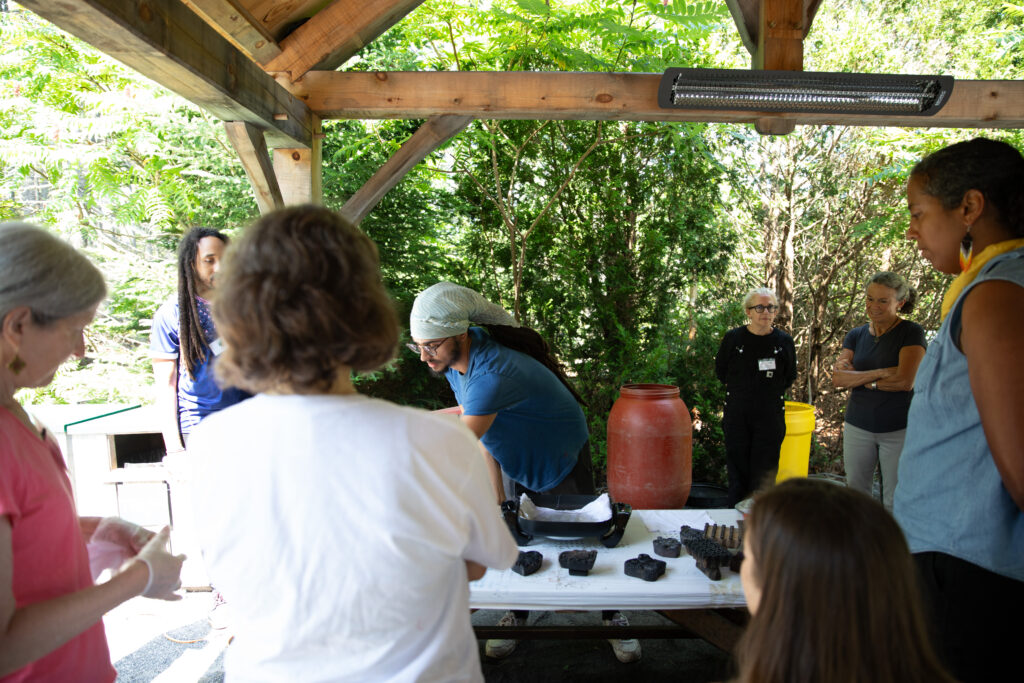
In Origins by Ava DuVarney, she takes the book Caste by Isabella Wilkerson, which looks at the Holocaust, the treatment of the Dalit in India and slavery here in the U.S. and connects them through the theme of subjugation. It is powerful and deeply disturbing to see what one group of human beings can do to another. Throughout the movie the author suffers her own personal tragedies exemplified in part, by the house she shared with her now deceased husband that has long needed a few repairs. She is tempted to move – that house is a reminder of her life before her husband’s passing and dealing with her grief and anger at times has been too much. But in the end, she says that “you escape trauma by confronting it”. I can’t help but think about how often I have heard people say, “I was never a slave owner” or “my family never treated people that way” or “that was a long time ago” in reference to the Indigenous and Black experience of land and belonging in the U.S. But it’s part of our legacy and our collective memory. It’s in our DNA. Whether we like it or not, as Isabelle Wilkerson poignantly points out, “we are the heirs” and “the cracks won’t fix themselves”. This is our house. This is our history. And we have a chance to do better in order to be better.
I was humbled by their courage to challenge the past and generate new possibilities in spite of their own country’s complex and messy histories that could create life-threatening situations for them. As the only American in the room, I was reminded that the health of a people and the land they live on and with, is a global issue. The details may be different, but when environmental entities – be it parks, botanical gardens, or any institution designed to inform our relationship to the environment – are willing to examine their own complicity and do the hard work of repairing what we have created, a different world becomes possible. In partnership with Indigo Arts Alliance, the Coastal Maine Botanical Gardens have flung open their doors to this conversation and relationship to grow the possibilities and connect with the wider Maine community. A new story awaits. Won’t you join us?
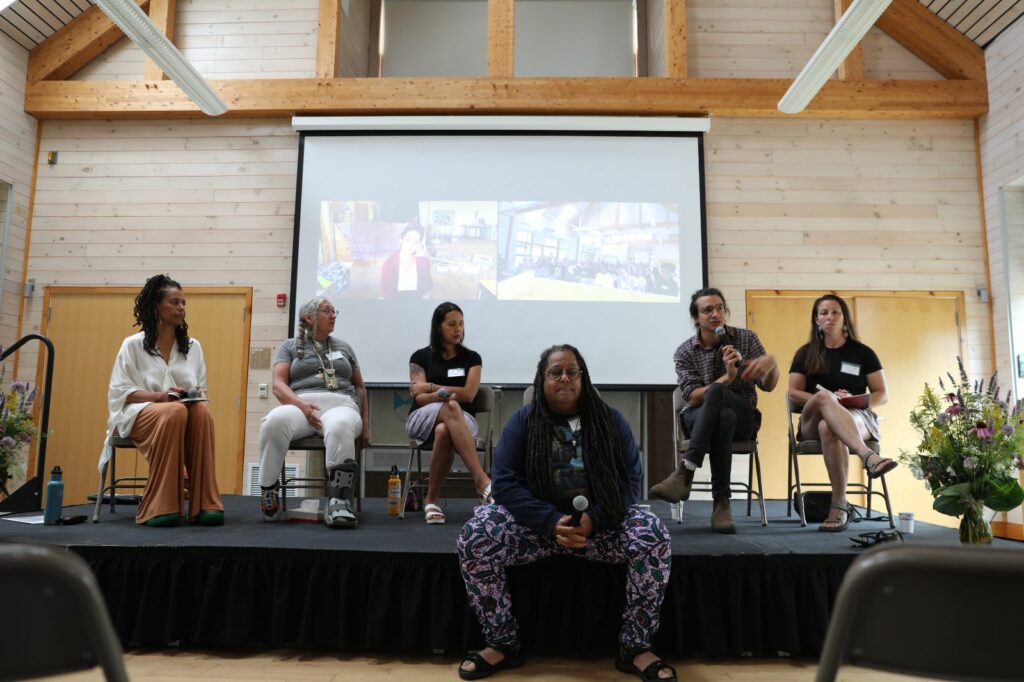

Carolyn Finney
Carolyn Finney, PhD is a storyteller, author and a cultural geographer who is deeply interested in issues related to identity, difference, creativity, and resilience. Grounded in both artistic and intellectual ways of knowing (pursuing an acting career for eleven years and backpacking around the world before returning to school to complete three degrees), she is passionate about interrogating our past and dreaming a future that is liberatory, just and green. Along with public speaking, writing, media engagements and consulting, she served on the National Parks Advisory Board and is the author of numerous publications, most notably her first book, Black Faces, White Spaces: Reimagining the Relationship between African Americans and the Great Outdoors (2014). She was a Fulbright Scholar, a Canon National Parks Science Scholar and has received two Mellon Fellowships, including a residency at the New York Botanical Gardens. She is currently working on her second book and is a scholar/artist in residence in the Franklin Environmental Center at Middlebury College.
Website: https://www.carolynfinney.com/
Symposia Page: https://indigoartsalliance.me/symposia-a-future-of-land-and-food-resilience/
